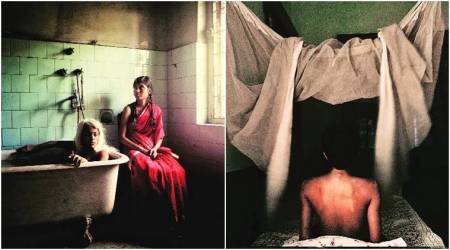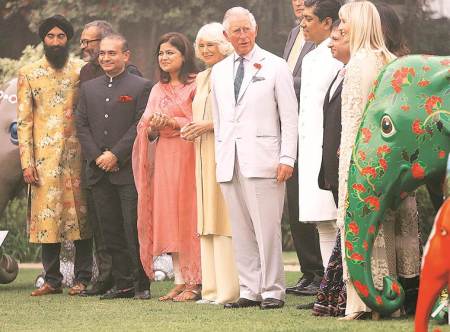 Residents of Urur Olcott Kuppam getting ready for the vizha. (Source: EP Unny)
Residents of Urur Olcott Kuppam getting ready for the vizha. (Source: EP Unny)
Is Chennai beginning to look away from its pet icons? You spend a whole evening with a diverse crowd here without hearing a word about Rajinikanth, Kamal Haasan or whoever is running the state after Jayalalithaa. Far from iconic, the only presence on Elliot’s Beach that stands out is a beaming man parading a Great Dane. The amiable canine gets all the attention.
Soon, a little girl catches your eye. Standing on a parked bike, the wide-eyed toddler is tiptoeing for a good glimpse of Kathak dancers on the makeshift stage. She begins to sway and the effect is instant. Siva, a familiar grandfatherly figure in the neighbourhood, breaks into dance even as the choreography switches to a Subramania Bharati song. Only, an anxious compere keeps reminding you that a Tamil composition is being remarkably linked to the north Indian dance form.
At this fishing settlement, Urur Olcott Kuppam, the audience couldn’t care less. Over the recent past, it has seen a good deal of leaps and bounds across cultural divides thanks to the vizha, an annual festival that brings an unusual range of classical, folk, martial and devotional art forms, mixed and matched most subversively. It is the fourth edition of the fest and people are far from awed. They respond to the performances with much ease and no qualms.
 (Source: EP Unny)
(Source: EP Unny)
Where else can you find audiences rocking to Kathak or Bharatanatyam? Elsewhere in Chennai’s hallowed chambers of music and dance, the audience comes alive only when the performer predictably pauses for applause. Not just cell phones, even heart beats would seem to be switched off during concerts.
The vizha viewers haven’t been mercifully tutored in appropriate appreciation. The organisers have, instead, shifted the emphasis from lazy wonderment to participation. The results are evident. Priyadarshini, a Class VII student at Olcott School, is already a vizha veteran. “First year, I did Villu Pattu (a traditional form of musical story telling), Bharatanatyam in the second, again Villu Pattu in the third, this time a political adaptation. Yesterday, I played a role in Tataki, a Ramayana-based Tamil play that de-demonises the title character,” she says. Her co-star Naresh, smiles through the lingering makeup and hopes to find a bigger role next year.
 (Source: EP Unny)
(Source: EP Unny)
Their confidence is growing and so would their viewership. A few aunts and uncles are already walking across from the city’s high culture quarters. More will follow. Out of sheer curiosity or a certain keenness not to miss out on the action on the alien sands. The invisible border, you are told, is somewhere near Besant Nagar’s Thalappakatti Biriyani place. Prime movers like musician TM Krishna and environmental activist Nityanand Jayaraman and student volunteers cross this border many times round the year. Between the first two and their key ally in the settlement, Saravanan Kasi, much work must happen to manage a series of beach based and outreach programmes with no sponsors, only crowd funding. This year, Krishna sang a public concert at the beach and collected over a lakh of rupees. You will get the exact figure when they upload the annual accounts on the web.
Can’t find better spokespersons than the three mentioned above. All three articulate with precision and it hasn’t helped. Big morning paper runs a front page picture with a caption that commends the fest for taking classical arts to the fishing community. Even student volunteers find such condescension embarrassing. Two of them who grew up with the vizha agree to talk. Younger voices, simpler to report…?
 (Source: EP Unny)
(Source: EP Unny)
Both, in Class XII in The School KFI founded by Jiddu Krishnamurti, turn out to be more nuanced than you bargained for. Tara is into martial Kalari and Arya has trained a good 10 years in classical Bharatanatyam. Neither finds any insight or instant synergy in the vizha. “It is lot more fun. A lot more is going on instead of familiar events before predictable audiences. The beach by itself is a lively environment,” says Tara. In the four years she has been volunteering, she did broaden her appreciation of folk forms. “I love the rhythm of the para.”
Arya says you can get excited about any event out here without understanding it. Also, over the years, it has become easier to walk across. “Initially, I wondered what to wear while visiting Kuppam. It is far more normal to go there now.” She loves the way the vizha has moved out of the beach to reach commuters in the city bus.
Even more than the art forms what entertains both is the south city elite who turn up to protect the beach and the breeze, seen as part of their pension package. The local worthies cite microbiology, “Go away! Stage light kills photosensitive organisms in the sand.”
For all the latest Eye News, download Indian Express App




































